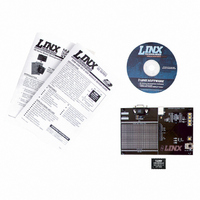MDEV-USB-QS Linx Technologies Inc, MDEV-USB-QS Datasheet - Page 3

MDEV-USB-QS
Manufacturer Part Number
MDEV-USB-QS
Description
KIT DEV MASTER USB QS SERIES
Manufacturer
Linx Technologies Inc
Series
QSr
Type
USBr
Datasheet
1.MDEV-USB-QS.pdf
(7 pages)
Specifications of MDEV-USB-QS
Supply Voltage (min)
7 V
Product
RF Development Tools
Supply Voltage (max)
16 V
Lead Free Status / RoHS Status
Contains lead / RoHS non-compliant
For Use With/related Products
QS Series
Lead Free Status / Rohs Status
Lead free / RoHS Compliant
THE RS-232 AREA
Figure 4: RS-232 Section
THE MICROCONTROLLER AREA
Figure 5: Microcontroller Section
Figure 6: Software Send and Receive via USB Section
Page 4
The RS-232 area contains a RS-232 level converter that, when used with the QS
Series module, creates a USB-to-RS-232 converter. All of the modem lines are
provided to allow for full handshaking, and power is provided by the USB bus. To
use, simply plug the USB cable from the PC into the jack, a straight-through
serial cable from the PC into the DB9 connector, place the jumper in the breakout
header between “Data In” and “Data 232”, and you may now run the software.
The development software is designed so that testing can be done with a single
PC by sending data through the USB bus and receiving it back through the serial
port and vice versa. This section can also be used to interface the PC with any
RS-232 device. Custom software can be written to control the device directly, or
the Virtual COM Port drivers can be used to make the USB module look like an
additional serial port so that existing software can be used.
The microcontroller area contains a PIC microcontroller from Microchip and
demonstrates how to interface the QS Module with a processor. Figure 5 shows
the Microcontroller area on the development board and Figure 6 shows the Send
and Receive via USB section in the development software.
THE MICROCONTROLLER AREA (CONT.)
THE PROTOTYPING AREA
Figure 7: Prototyping Area
The software will send data to the microcontroller to turn on LEDs when the user
clicks the LED1, LED2, or LED3 buttons on the computer screen. The
microcontroller will send data to the PC to light up the USB COM indicator on the
screen when the USB COM button on the board is pressed. The microcontroller
will also send data to control the A / D Voltage Adjust slider when the Voltage
Adjust knob on the board is turned. Source code examples are provided with the
software documentation to demonstrate the simplicity of interfacing the QS
module with a processor and to aid in product development.
The USB bus provides all of the power for this section. To use, plug a USB cable
into the jack and the PC, place the jumper in the breakout header between “Data
In” and “Data PIC”, and run the application software included with the kit.
The prototyping area contains an area of plated through holes so that external
circuitry can be placed on the board. This circuitry can be interfaced with the QS
module through the breakout header to the right. At the bottom of this area is a
row connected to ground and at the top is a row connected to the USB power
supply. The circuitry on the development board will draw approximately 40 to
50mA of current, so any circuitry added to the prototyping area cannot draw
more than 50mA before enumeration, per the USB specification (please see the
Power Supply Guidelines in the module’s data guide for more information). If the
circuitry will require more current, then an external power supply will be required.
Resistor R10 is a 0-ohm jumper that can be removed to isolate the power supply
row from the USB supply so that an external supply can be attached to this row.
All of the module’s control and data lines are connected to the header, allowing
easy access from the prototyping area. A jumper is also included to route the
data from the RS-232 Section or the Microcontroller section to the QS module. It
must be appropriately set before the sections will work properly.
Page 5



















